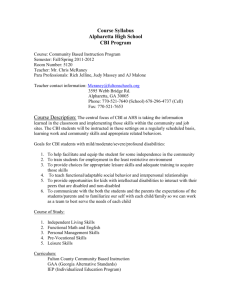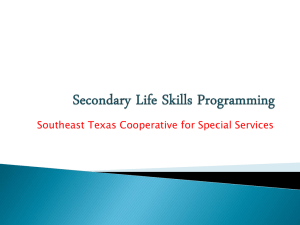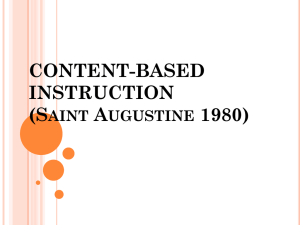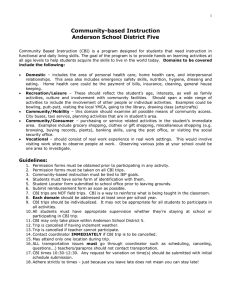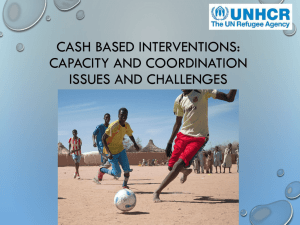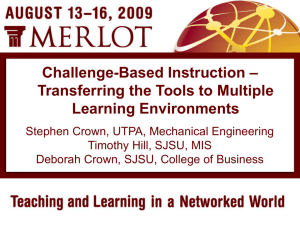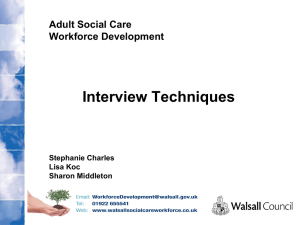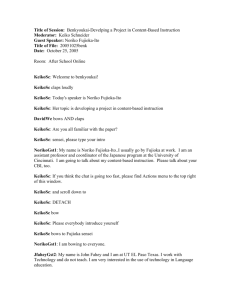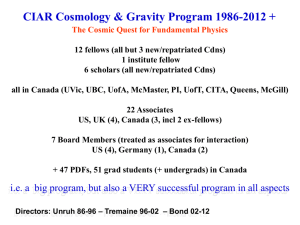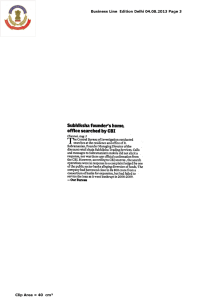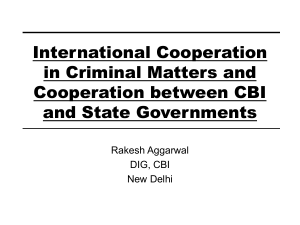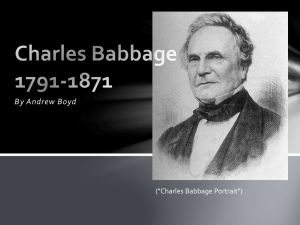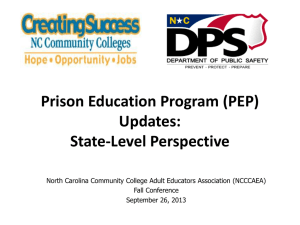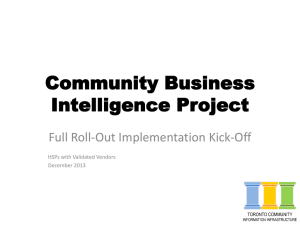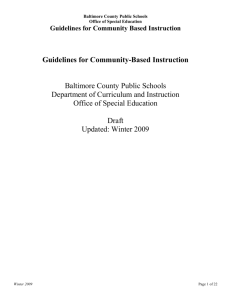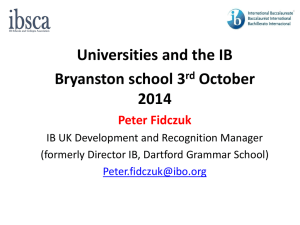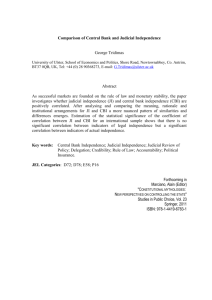Completing Effective Community Based Instruction
advertisement
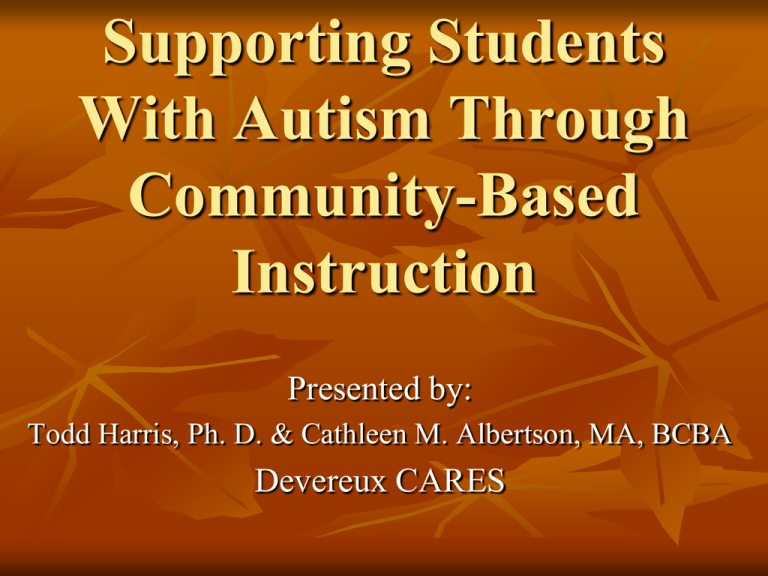
Supporting Students With Autism Through Community-Based Instruction Presented by: Todd Harris, Ph. D. & Cathleen M. Albertson, MA, BCBA Devereux CARES Overview of Presentation Introduction to CBI Objectives of CBI Pre-CBI Assessment Implementation of CBI Ongoing Evaluation and Modifications Community-Based Employment Training Service Learning What is CBI? It’s an educational process that provides planned and highly structured learning opportunities beyond an individual’s classroom, immediate work environment, and home. Focuses on those skills that will allow the student to be as independent as possible, particularly for adulthood Primary Goal of CBI To teach skills that will lead to greater independence and a higher quality of life for each student by enabling them to successfully participate in community trips with their family and friends. General Objectives of CBI Teach general and specific skills that will lead to greater independence in community settings (e.g., waiting in line at the grocery store, ordering from a menu, etc.) Generalize other IEP objectives to community settings (such as social skills, communication, and so on) Establish or maintain appropriate behavior in new (and usually less structured) settings Increase an individual’s interactions with typically-developing peers Who Should Participate in CBI? At what age should CBI begin? Who Should Participate in CBI? Any individual with community skills that are not at the level of same-age peers Any individual that exhibits challenging behaviors in community settings Any individual that needs structured employment training Domain Areas Related to CBI Social Skills Communication Skills Leisure/Recreation Skills Shopping/Purchasing Accessing Services (e.g., restaurants, post office, library, etc.) Travel & Safety Employment Setting Up and Implementing CBI Pre-CBI Assessment Implementation of CBI Ongoing Evaluation & Modification Pre-CBI Assessment Gain information regarding present skills and behavioral issues from family/caregivers and all team members Ask the family to identify settings and situations that they would like to visit but do not or cannot presently Identify which pivotal skills (i.e., skills needed across settings) are not yet acquired (e.g., communication, social, academics or functional academics, employment). Once settings are identified, conduct “ecological assessments” Excerpt from Family CBI Survey Fast Food How Often Do you Go? (e.g., daily, weekly, monthly) Priorities for Instruction (e.g., ordering food, waiting for food, paying, trying new foods, etc) How Often Do you Go? (e.g., daily, weekly, monthly) Priorities for Instruction (e.g., ordering food, waiting for food, paying, trying new foods, etc) 1. 2. 3. Table Service 1. 2. 3. Excerpt from Family CBI Survey CONVENIENCE STORES: What convenience store do you shop at most frequently (circle one): Wawa 7-11 Turkey Hill LEISURE ACTIVITIES: What leisure activities does your child currently participate in? Examples include visiting parks, shopping malls, sports, swimming, movies, etc. What leisure activities would you like your child to learn? Let’s look at the CARES Skills Checklist Pre-CBI Assessment Person-Centered Future’s Planning A process for identifying the individual’s hopes/dreams, clarifying the vision for the future, identifying the steps to reach life goals by including community supports. (At CARES we typically start this at age 14) Meetings include the student, family members, friends, school personnel, and other agency contacts The following is also discussed: Preferences related to activities (recreational and work), people, sensory input, and community environments A description of strengths and needs, particularly related to social skills, communication, and behavioral challenges Needed supports to ensure success (staffing, medical/physical, behavioral, and visual aids) The end result is an action plan for the next year This process should be repeated annually Pre-CBI Assessment Ecological Assessment – a process for surveying current and future environments to determine what specific skills are needed in those settings Once these settings are identified, visit to assess needed skills and possible environmental challenges Situational Assessment: important to allow student to experience community settings. Compare student’s performance to typically-developing peer and perform discrepancy analysis. Ecological Inventory Excerpt When visiting a setting, you may want to observe some of the following: General accessibility of the setting. What orientation and mobility skills are required? General safety considerations Special equipment or clothing necessary (e.g., uniform)? What types of communication and social skills are required? Natural cues or reinforcers available? Owner’s or manager’s response to using site for instruction? Implementation of CBI Determine if you need to give information to staff working in the settings that you are visiting Determine what resources are needed (transportation, staffing, money, supervision) Determine if instruction will occur individually or in a group Select instructional strategy Many tasks required in community settings have many steps (e.g., making a purchase, ordering food at McDonald’s), therefore chaining procedures are often used Forward Chaining Backward Chaining Total-task Presentation Implementation of CBI Determine prompt strategy: Often necessary to deliver prompts because many students with autism do not attend to cues in the natural environment to initiate a task independently or to complete a task Determine if additional reinforcement procedures will be necessary: CBI itself is a highly preferred and motivational activity for many students. If necessary to use additional reinforcement procedures strive for as naturalistic as possible so as not to call undue attention to student. Implementation of CBI Generalization and Maintenance Many students do not generalize skills from school and home to community settings unless directly taught to do so Variety of methods General-case instruction may have the best generalization outcomes Identify generalization conditions Identify variations of the relevant stimuli and responses Teach individual to respond under all conditions Example: Washing Hands Example: Washing Hands Example: Washing Hands Working Together As A Team To enhance skill acquisition and generalization, it is important that professionals and families work together to provide continuity in community settings Two- way information can be shared via: Team meetings Sharing lesson plan summaries and intervention strategies and materials Meeting in the community Visual Supports to Enhance Independence We all use visual supports everyday Daytimers and calendars Post-it notes/to-do lists Menus Written instructions/signs Strategic placement of materials Tables and graphs Many individuals with autism are visual learners Categories of Visuals Schedules Learning tasks and/or routines Reward systems Communication Social skills Individual Mini-Schedules Reward Systems Reward Menu Let’s look at some video Ongoing Evaluation & Modifications Develop data systems that are efficient and reliable Organize data so that ongoing progress can be assessed – however, should be nonobtrusive Use data and other information sources to make decisions about progress and needed modifications Social validity Service Learning A volunteer experience which encourages participation in organized activities for the good of the community. It integrates education, character, personal growth, skills, and the development of socially acceptable attitudes and values focusing on citizenship and civic responsibility. It is a cycle of action and reflection. Service Learning Students with autism can make meaningful contributions to their local communities. These students can help educate community members about autism and the capabilities of students with autism. While participating in service learning activities, they are able to work on their IEP objectives in functional and “real-life” situations How will Students Specifically Benefit? By working on… Social and Communication Skills Problem Solving Skills Academics and Functional Academics Community Skills Employment Skills Motor Skills Through enhancement of their own self-esteem, sense of social responsibility, and concern for others The Process of Service Learning 1 – Self-assessment 2 – Community assessment 3 – Choose an issue 4 – Conduct research 5 – Create a plan 6 - Implementation 7 – Celebration 8 – Evaluation/Reflection Examples of Service Learning Recycling Thrift store Supporting the troops One warm coat Canned food drive Balloonacy – St Judes SPCA Presents From The Troops! Community-Based Employment Training Ongoing assessment of general strengths and needs Target specific employment skills Continue working on critical global skills (e.g., communication, social, hygiene, behavioral) Student preferences and happiness Situational assessments and time studies Employment Exploration Community-Based Employment Experiences Training Sites Job Carving Customized Employment Individual Work Sites with Support Competitive Employment Community-Based Employment Training 12 to 15 Years Increase learning time in the community Provide opportunities to engage in Service Learning activities within neighborhood/community Begin/continue adolescent and employment assessments, and person-centered futures planning May be a shift toward increased chores/work tasks within school environments Begin rotation through community-based employment training sites Continue to help family plan for post-21 transition Community-Based Employment Training 16 to 17 Years Continue with previous activities Increase time in employment training sites Begin to develop work portfolio 18 to 21 Years Begin placement at individual site based upon results of various assessments and proximity to home Finalize plans for post-21 transition Let’s look at some video Thanks For Listening!
